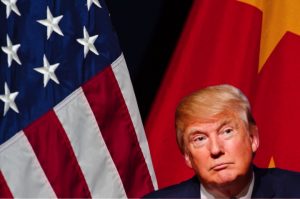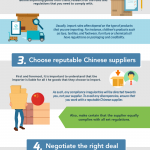China Cuts Import Tariffs Creating Big Opportunity for Exporters
Good news is here for U.S. producers and exporters of consumer goods.
Last year, the U.S. trade deficit with China was over 300 billion dollars. Here are the numbers from the U.S. Trade Representative’s office:
U.S. goods and services trade with China totaled an estimated $648.2 billion in 2016. Exports were $169.3 billion; imports were $478.9 billion. The U.S. goods and services trade deficit with China was $309.6 billion in 2016.
Obviously, that’s not the good news. Those numbers show economies much friendlier for U.S. shippers to import from China than for U.S. shippers to export to China.

Picture of Donald Trump by Michael Vadon. U.S. & Chinese flags added.
The U.S. trade deficit with China was a huge part of Donald Trump’s presidential campaign. Huge. While there’s plenty of controversy in the now president’s words, policies, and views, there’s no debating that China is highly protectionist, putting a disadvantage on its trade partners to export to the country anywhere close to as much as they import from China.
Now, steps are being taken toward leveling the playing field.
Starting this month (on December 1st, actually), China cut tariffs on close to 200 consumer goods. The news that this was coming actually broke last month. BBC News reported:
China is cutting import tariffs on 187 consumer goods from whisky to cashmere clothing to help spur spending and economic growth.
The Finance Ministry said tariffs will drop from an average 17.3% to 7.7% on products, including pharmaceuticals, food, health supplements and clothing.
Perhaps not coincidentally, this tariff cut announcement came shortly after President Trump made a trip to China. While the trip was much criticized, $250 billion in deals between U.S. companies and China were announced.
Investor’s Business Daily posted an editorial on the news that opened with:
During President Trump’s trip to China, the U.S. scored some $250 billion in deals for such major companies as Boeing, General Electric and Qualcomm. It’s a nice haul, but Trump’s time in China would better be spent reducing barriers to trade overall.
I don’t want to sound critical of that editorial as it is a good article, but the tariff cuts (announced after the publication of the editorial) are exactly that: a reduction of trade barriers.
There were other promises to reduce trade barriers from China last month as well. The Los Angeles Times posted an article from the Associate Press about the tariff cuts that also reported:
Beijing promised Nov. 10 to gradually reduce tariffs on auto imports, though it gave no details. It was unclear how that might affect imports because most of the vehicles sold in China by global automakers are made in China.
…
Also on Nov. 10, the government announced it would lift its limit on foreign ownership of securities, fund management and futures companies from a minority stake of 49% to a majority stake of 51% and end restrictions after three years. It said a similar change would be made for life insurance companies and those restrictions would end in five years.
There’s still a long way to go in making a level trading ground between the U.S. and China; however, Beijing is showing willingness if not desire to open its market.
Now is an opportune time for U.S. companies to export to China. And the U.S. trade deficit with China just may start falling.




